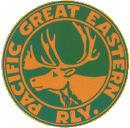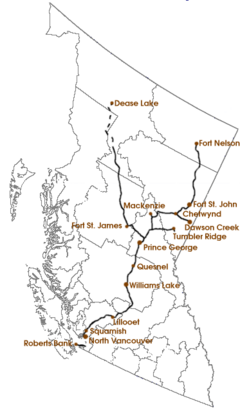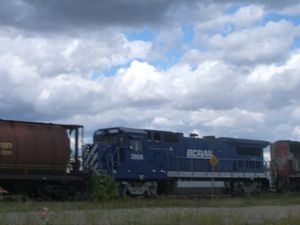BC Rail
| BC Rail | |
|---|---|
| Reporting marks | BCOL, BCIT (formerly PGE and PGER) |
| Locale | British Columbia |
| Dates of operation | 1912 – 2004 |
| Track gauge | 4 ft 8½ in (1435 mm) (standard gauge) |
| Headquarters | North Vancouver, British Columbia |
BC Rail (AAR reporting marks BCOL and BCIT), known as the British Columbia Railway between 1972 and 1984 and as the Pacific Great Eastern Railway (PGE; AAR reporting marks PGE and PGER) before 1972, was a railway that operated in the Canadian province of British Columbia between 1912 and 2004. It was a class II regional railway and the third-largest in Canada, operating 2 320 km (1,441 miles) of mainline track. It was owned by the provincial government from 1918 until 2004, when it was sold to Canadian National Railway.[1]
Chartered in 1912, the railway was acquired by the provincial government in 1918 after running into financial difficulties. A railway that ran "from nowhere, to nowhere" for over 30 years, neither passing through any major city nor interchanging with any other railway, it expanded significantly between 1949 and 1984. Primarily a freight railway, it also offered passenger service, as well as some excursion services, most notably the Royal Hudson excursion train. The railway's operations were not always profitable, and its debts, at times, made it the centre of political controversy.
Contents
History
1912–1948
The Pacific Great Eastern Railway (PGE) was incorporated on February 27, 1912, to build a line from Vancouver north to a connection with the Grand Trunk Pacific Railway (GTP) at Prince George. Although independent from the GTP, the PGE had agreed that the GTP, whose western terminus was at the remote northern port of Prince Rupert, could use their line to gain access to Vancouver. The railway was given its name due to a loose association with England's Great Eastern Railway. Its financial backers were Timothy Foley, Patrick Welch and John Stewart, whose construction firm of Foley, Welch and Stewart was among the leading railway contractors in North America. Upon incorporation, the PGE took over the Howe Sound and Northern Railway, which at that point had built nine miles (15 km) of track north of Squamish.[2] The British Columbia government gave the railway a guarantee of principal and 4% interest (later increased to 4.5% to make the bonds saleable) on the construction bonds of the railway.[3]
By 1915, the line was opened from Squamish 176 miles (283 km) north to Chasm. The railway was starting to run out of money, however. In 1915 it failed to make an interest payment on its bonds, obliging the provincial government to make good on its bond guarantee. In the 1916 provincial election campaign, the Liberal Party alleged that some of the money advanced to the railway for bond guarantee payments had instead gone into Conservative Party campaign funds. In the election, the Conservatives, who had won every seat in the legislature in 1912 election, lost to the Liberals. The Liberals then took Foley, Welch, and Stewart to court to recover $5 million of allegedly unaccounted funds. In early 1918, the railway's backers agreed to pay the government $1.1 million and turn the railway over to the government.[4]
When the government took over the railway, two separate sections of trackage had been completed: A small section between North Vancouver and Horseshoe Bay, and one between Squamish and Clinton. By 1921, the provincial government had extended the railway to a point 15 miles (24 km) north of Quesnel, still 20 miles (32 km) south of a connection to Prince George, but it was not extended further. The track north of Quesnel was later removed. Construction of the line between Horseshoe Bay and Squamish was given a low priority because there was already a barge in operation between Squamish and Vancouver, and the railway wanted to discontinue operations on the North Vancouver-Horseshoe Bay line. However, the railway had an agreement with the municipality of West Vancouver to provide passenger service that it was unable to get out of until 1928, when they paid the city $140,000 in support of its road-building programme. The last trains on the line ran on November 29, 1928, and the line fell into disuse, but was never formally abandoned.[5]
For the next 20 years the railway would run from "nowhere to nowhere". It did not connect with any other railway, and there were no large urban centres on its route. It existed mainly to connect logging and mining operations in the British Columbia interior with the coastal town of Squamish, where resources could then be transported by sea. The government still intended for the railway to reach Prince George, but the resources to do so were not available, especially during the Great Depression and World War II. The unfortunate state of the railway caused it to be given nicknames such as "Province's Great Expense", "Prince George Eventually", "Past God's Endurance", and "Please Go Easy".
1949 to 1971
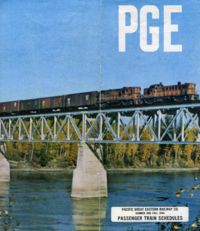
Starting in 1949, the Pacific Great Eastern began to expand. Track was laid north of Quesnel to a junction with the Canadian National Railways at Prince George. That line opened on November 1, 1952. Between 1953 and 1956 the PGE constructed a line between Squamish and North Vancouver. The PGE used their former right-of-way between North Vancouver and Horseshoe Bay, to the dismay of some residents of West Vancouver who, mistakenly believing the line was abandoned, had encroached on it. The line opened on August 27, 1956. By 1958 the PGE had reached north from Prince George to Fort St. John and Dawson Creek.
In 1958, British Columbia Premier W.A.C. Bennett boasted that he would extend the railway to the Yukon and Alaska, and further extension of the railway was undertaken in the 1960s. A 23 mile (37 km) spur was constructed to Mackenzie. A third line was extended west from the mainline (somewhat north of Prince George) to Fort St. James. It was completed on August 1, 1968. The largest construction undertaken in the 1960s was to extend the mainline from Fort St. John 250 miles (400 km) north to Fort Nelson, less than 100 miles (160 km) away from the Yukon. The Fort Nelson Subdivision was opened by Premier Bennett on September 10, 1971. Unfortunately, the opening of the line was overshadowed by the inaugural train derailing south of Williams Lake, south of Prince George.
1972 to 1989
The railway underwent two changes of name during this time period. In 1972, the railway's name was changed to the British Columbia Railway (BCR). In 1984, the BCR was restructured. Under the new organization, BC Rail Ltd. was formed, owned jointly by the British Columbia Railway Company (BCRC) and by a BCRC subsidiary, BCR Properties Ltd. The rail operations became known as BC Rail.
In 1973, the British Columbia government acquired and restored an ex-Canadian Pacific Railway 4-6-4 steam locomotive of the type known as "Royal Hudsons", a name that King George VI permitted the class to be called after the Canadian Pacific Railway used one on the royal train in 1939. The locomotive that the government acquired, numbered 2860, was built in 1940 and was the first one built as a Royal Hudson. The government then leased it to the British Columbia Railway, which started excursion service with the locomotive between North Vancouver and Squamish on June 20 1974. The train ran between June and September on Wednesdays through Sundays.
In the 1960s, a new line had been projected to run northwest from Fort St. James to Dease Lake, 412 miles (663 km) away. On October 15, 1973, the first 125 miles (201 km) of the extension to Lovell were opened. The cost of the line was significantly greater than what was estimated, however. Contractors working on the remainder of the line alleged that the railway had misled them regarding the amount of work required so that it could obtain low bids, and took the railway to court.
The Dease Lake line was starting to appear increasingly uneconomical. There was a world decline in the demand for asbestos and copper, two main commodities that would be hauled over the line. As well, the Cassiar Highway that already served Dease Lake had recently been upgraded. Combined with the increasing construction costs, the Dease Lake line could no longer be justified. Construction stopped on April 5, 1977. Track had been laid to Jackson, 263 miles (423 km) past Fort St. James, and clearing and grading were in progress on the rest of the extension. It had cost $168 million to that point, well over twice the initial estimate. The trackbed can be seen on Google Earth all the way to Dease Lake, via the small towns of Leo Creek and Takla Landing, British Columbia.
The management and operation of the railway had been called into question, and on February 7, 1977, the provincial government appointed a Royal Commission, the McKenzie Royal Commission, to investigate the railway. Its recommendations were released on August 25, 1978. It recommended that construction not continue on the 149 miles (239 km) of roadbed between Dease Lake and the current end of track, and that trains be terminated at Driftwood, 20 miles (33 km) past Lovell. The rest of the track would be left in place but not used. In 1983, after logging operations ceased at Driftwood and traffic declined sharply, the Dease Lake line was closed. However, it was reopened in 1991 and, as of 2005, extends to a point called Chipmunk, British Columbia, still over 175 miles (281 km) south of Dease Lake. Many of the Commission's other recommendations, including the abandonment of the Fort Nelson line, and discontinuation of uneconomic operations such as passenger services, were not followed.[6]
In the early 1980s the railway built a new line and acquired another. The Tumbler Ridge Subdivision, an 82 mile (132 km) electrified branch line, opened in 1983 to the Quintette and Wolverine mines, two coal mines northeast of Prince George that produced coal for Japan. It has the lowest crossing of the Rocky Mountains by a railway, at 3,815 feet (1 163 m). There are two large tunnels under the mountains: The Table Tunnel, 5.6 miles (9 km) long, and the Wolverine Tunnel, 3.7 miles (6 km) long. Electrified owing to the long tunnels and close proximity to the W. A. C. Bennett Dam and transmission lines, it was one of the few electrified freight lines in North America. Although initially profitable, the traffic on the line was never as high as initially predicted, and by the 1990s was under one train per day. The railway had incurred much debt building the branch line, and the expensive, unprofitable operations on the branch line could not help to repay that debt. In 1984 BC Rail acquired the British Columbia Harbours Board Railway, a 23 mile (37 km) line that connects three class I railways with Roberts Bank, an ocean terminal that handles coal shipments. Since the line had been constructed in 1969, it had previously been leased to CP Rail, Burlington Northern Railroad, and Canadian National Railway in succession.
1990 to 2003
In the early 1990s, the provincial government reduced subsidies to BC Rail. As a result, BC Rail, burdened with several money-losing services that it was required to operate, saw its debtload grow more than sixfold between 1991 and 2001.
In the 1990s, BC Rail branched out into shipping operations, acquiring terminal operator Vancouver Wharves in 1993 and Canadian Stevedoring and its subsidiary, Casco Terminals, in 1998. In 1999 these operations became the three operating divisions of a new entity, BCR Marine. BCR Group became the parent company of both BCR Marine and BC Rail. In early 2003, attempting to reduce the railway's large debt, BCR Group sold its BCR Marine assets except for Vancouver Wharves (which was also not included in the subsequent sale of BC Rail to Canadian National, and remains a provincial Crown corporation).[7]
On August 19 2000, the Quintette mine closed, and the portion of the Tumbler Ridge Subdivision between Teck and Quintette, British Columbia, was abandoned. The last electric locomotives ran along the line on September 29, 2000, after which the line was worked by diesels. The Wolverine mine closed on April 10, 2003, after which the remaining 69.6 miles (112 km) of the Tumbler Ridge Subdivision between Teck and Wakely was abandoned, although the track is still in place. The electric locomotives were shipped south to Tacoma, Washington, where they are being dismantled by CEECO Rail Services. One of the locomotives was preserved in the British Columbia Railway & Forest Industry Museum in Prince George.
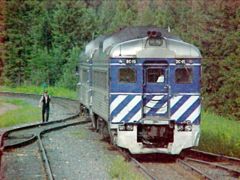
Several other services were also discontinued around this time. The Royal Hudson steam train excursion was discontinued at the end of the 2001 excursion season. The 2860 was out of service in 2000, needing extensive repairs. The backup steam locomotive, a 2-8-0 locomotive built for the Canadian Pacific Railway in 1912, broke down in May 2001, and for the rest of the season BC Rail used a former Canadian Pacific Railway FP7A diesel locomotive #4069 that it had leased from the West Coast Railway Association in Squamish. Passenger train service which consisted of the Budd-RDC operated Cariboo Prospector and Whistler Northwind trains ended October 31, 2002. The service was unprofitable, partly owing to BC Rail's heavy dependence on their fleet of aging Budd Rail Diesel Cars (RDC) that were becoming increasingly expensive to keep in service. The RDCs have since been sold to various museums and operators around North America, (such as the Wilton Scenic Railroad in New Hampshire and the West Coast Railway Association in Squamish). Service between Seton Portage and Lillooet was replaced by a railbus. As well, around this time BC Rail ended its intermodal service.[8]
The success story that continues to get lost however, is that BC Rail centralized its operating department during 2000/2001. This did lead to some growing pains during early implementation which may have helped build the case for the sale to CN, but by March 2002, BC Rail was on the verge of a significant recovery. The synergies related to the entire operation being run on one floor lead to huge gains in productivity. For example, empty online cycle times for lumber equipment improved over 40 percent between 2001 and 2003 and continued to improve in 2004 prior to the sale. Profitability at BC Rail made huge gains even with the loss of coal traffic and the business sense of the sale was debated furiously. It has been speculated that what should have been THE success story in North American railroading for 2003 and 2004 had to be hidden from the press in order to complete the sale. Some have said that BC Rail's centralized yard operations strategy could have been a model for North American railroads plagued with inefficiencies and congested yards. Others have speculated that BC Rail needed to be sold before they proved again that a government owned business could in fact turn a significant profit.
Sale to CN Rail
On May 13, 2003, British Columbia Premier Gordon Campbell announced that the government would sell the operations of the railway (including all of the assets other than the rail right-of-way).[9] During the previous election, he had specifically promised not to sell the railway and he maintained that he was keeping this promise, by retaining ownership of the right-of-way and only leasing the land to the operator. On November 25, 2003, it was announced that Canadian National's (CN) bid of $1 billion would be accepted over those of several other companies. The transaction was closed on July 15, 2004.[7] The original lease of the rail right of way was for 60 years with a 30 year option to renew. However, it has been reported that there are another fifteen 60 year options to renew the lease in the contract documents and CN would not have to pay anything additional to keep operating for 990 years. At each of these renew dates, the BC government would have the option of buying back all of the assets from CN.
The one portion of the BC Rail line, not included in this sale was the section from Robert's Bank connecting to the main CN, CP and Burlington Northern Sante Fe Lines. Originally the operation of this line was to be sold off separately. However, there were a number of irregularities that came up during the sale process including a government employee, David Basi being accused of accepting a bribe from a lobbyist working on behalf of OmniTrax and CP withdrawing their bid because other bidders had access to secret government information. The sale was cancelled and the remnants of BC Rail Company continues to operate and maintain this line.
- See also BC Legislature Raids
CN era (2004– )
On August 5, 2005, a long CN train heading inland from Brackendale, derailed spilling 8 empty lumber flat cars and one tank car of sodium hydroxide. The tank car spilled its contents into the Cheakamus River, killing most of its fish.[10]
On June 29, 2006, a diesel locomotive hauling one flatcar of lumber down the steep Pavilion grade 18 miles north of Lillooet had its air brakes fail. The train gathered speed, until it derailed over a steep river benchland; two of the three crewmembers were killed.[11]
In other areas, CN has been limiting access across its rails to homeowners, and people who want river and rangeland access. Presently, it has become a concern. Previously, BC Rail had working arrangements with such stakeholders.
Freight services
The railway transported a wide variety of products, from resource traffic to intermodal freight. Forest products are one of the main products transported by the railway. Before the lease of operations to CN, the railway transported over 120,000 carloads of lumber, pulp, woodchips, and other forest products per year. The railway served several lumber and pulp mills in the province. Between 1983 and 2003, the railway hauled coal in unit trains from the Teck and Quintette mines near Tumbler Ridge to Prince George, from where CN would haul the trains to Prince Rupert for shipment to Japan. The Quintette mine, the larger-producing of the two, closed in 2000 and the Teck mine closed in 2003.
Starting in the 1960s, the PGE operated an intermodal service that transported truck trailers between North Vancouver and Prince George, and to places further north. Unlike most of the railway's other traffic, most of the intermodal traffic was northbound. In April 1982, the railway combined its piggyback and LCL services to form a new Intermodal Services Department. BC Rail halted its intermodal services in 2002. Starting in 1958, the railway started to haul grain from the Peace River District, serving grain elevators at Dawson Creek, Buick, Fort St. John, and Taylor. With an amendment to the Western Grain Transportation Act in 1985 that included the railway in the Act, it became economical for the railway to transport grain, and it also carried grain from Northern Alberta bound for Prince Rupert, interchanging with CN at Dawson Creek and Prince George.
From the 1920s to the 1960s, the railway also carried gold concentrate and bullion from the Bridge River goldfield towns of Bralorne and Pioneer Mine, which were trucked out of the goldfield area over 3500' Mission Pass to the railway at Shalalth. The main freight company operating out of Shalalth was Evans Transportation Co., which grew to be one of the biggest transportation companies in the province. In addition to gold concentrate and ore, Evans and other companies based in Shalalth carried passengers, heavy equipment, and supplies of all kinds over 3500' Mission Pass.
Interchanges
Between 1928 and 1952, the PGE did not interchange with any other railway. Connections were made to other railways when the railway expanded during the 1950s. The main connection to the North American rail network was in North Vancouver, where there was a connection to CN. There was also a rail connection to deep-sea terminal operator Vancouver Wharves, and some interchange occurred with the Union Pacific Railroad through the Seaspan railbarge link between North Vancouver and Seattle, Washington. The railway also interchanged with CN at Prince George, and with Northern Alberta Railways (acquired by CN in 1981) at Dawson Creek. CN's line between Dawson Creek and Hythe, Alberta, fell into disuse in 1998, but CN agreed to reopen it as a condition of purchasing BC Rail.[7]
Reporting marks
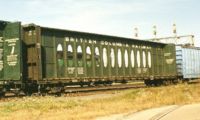
Reporting marks are a system intended to help keep track of rolling stock and financial transactions between railways. The Pacific Great Eastern Railway used the reporting mark PGE. It later adopted the reporting mark PGER in 1971 for freight cars in international service. When the railway was renamed to the British Columbia Railway, it adopted the reporting mark BCOL, as well as the BCIT reporting mark for freight cars in international service.
Passenger services
Since the line opened, the PGE had provided passenger service between Squamish and Quesnel (as well as between North Vancouver and Horseshoe Bay until operations were discontinued there in 1928). When the PGE reached Prince George and North Vancouver, daily service was extended to these cities. Service between Lillooet and Prince George was cut back to three times weekly in the 1960s. In 1978, the McKenzie Royal Commission recommended that the BCR eliminate its passenger services, which were losing over $1 million per year, unless it received government funding for them, but the BCR did not do so. However, facing large losses and an ageing fleet of Rail Diesel Cars, it reduced passenger operations to three trains weekly to Lillooet and once weekly to Prince George on February 16, 1981. This service reduction led to public outrage, and the British Columbia government agreed to provide subsidies for passenger operations. The previous level of service was restored on May 4, 1981.[12]
Passenger service ended on October 31, 2002. BC Rail replaced the service between Lillooet and nearby Seton Portage and D'Arcy with a pair of railbuses, called "track units" by the railway. The railbus makes at least one round trip between Seton Portage and Lillooet daily, and also serves D'Arcy if there is sufficient demand. The Seton Lake Indian Band manages ticket sales, marketing, and customer service for the shuttle service.
Passenger Services will return to the line in Summer 2006, with Rocky Mountaineer Railtours operating two services over the former BCRail route, the Whistler Mountaineer will operate between Vancouver and Whistler, with a separate service operating north from Whistler through Prince George to Jasper. The West Coast Railway Association is also due to return the Royal Hudson #2860 to service during 2006.
Excursion services
The railway's best-known excursion service was its Royal Hudson excursion service, which was the only regularly scheduled steam excursion service on mainline trackage in North America. Excursion service started on June 20, 1974, running between North Vancouver and Squamish. By the end of the first season 47,295 passengers had been carried. The Royal Hudson would become one of British Columbia's primary tourist attractions. It operated between May and October. It was cancelled at the end of the 2001 tourist season.[13]
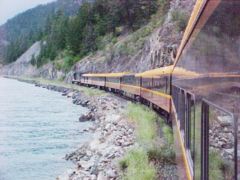
Two other excursion services were introduced by BC Rail in 1997 and 2001. In 1997, BC Rail introduced the Pacific Starlight dinner train, which ran in evenings between May and October between North Vancouver and Porteau Cove. In 2001, BC Rail introduced the Whistler Northwind, a luxury excursion train that ran between May and October, northbound from North Vancouver to Prince George or southbound from Prince George to Whistler. The train used several custom-designed dome cars. Both services were discontinued at the end of the 2002 season along with BC Rail's passenger service.
Historically, and discontinued in the 1960s, the railway at one time operated open-top observation cars all the way from North Vancouver to Lillooet and sometimes beyond.
A series of lodges of varying quality grew up along the railway, drawing on weekend tourist excursions from Vancouver via the MV Brittania steamer service to Squamish. The most famous of these was Rainbow Lodge at Whistler, then called Alta Lake, but others were at Birken Lake, Whispering Falls, D'Arcy, Ponderosa, McGillivray Falls, Seton Portage, the Bridge River townsite (where there was a first-class hotel serving mining and hydro executives and their guests), Shalalth, Retaskit and at Craig Lodge near Lillooet. The last-named was a swank tennis resort, its attraction being the extremely arid, sunny climate and the waters of Seton Lake.
Locomotives
Until the late 1940s, most motive power on the PGE was provided by steam locomotives. The majority of the railway's locomotives were of the 2-6-2, 2-8-0 and 2-8-2 (Whyte notation) wheel configurations. In addition, the railway also used a handful of gasoline cars, notably on a flatcar automobile ferry between Shalalth and Lillooet known simply as the Gas Car, once a vital lifeline for the communities of the upper Bridge River basin before the completion of a road from there to Lillooet.
The railway received its first diesel locomotive in June 1948, a General Electric 65-ton locomotive. Over the next two years the railway acquired six GE 70-ton locomotives. In the 1950s, the railway bought RS-3, RS-10, and RS-18 locomotives from the Montreal Locomotive Works (MLW). The railway had fully dieselized by 1956, and by the end of the decade had nearly 40 diesel locomotives. The railway would purchase new locomotives exclusively from MLW until 1980. During the 1970s, the railway also purchased several used locomotives, mostly American Locomotive Company (ALCO) models from American railways. In the 1980s, the railway acquired new SD40-2 locomotives made by General Motors Diesel (GMD), as well as used SD40-2s originally made by General Motors Electro-Motive Division (EMD). More recently, several locomotives were purchased from General Electric.
In 1970, the railway started using remote controlled mid-train locomotives, allowing longer and heavier trains to be operated through the steep grades of the Coast Mountains. It initially used separate remote control cars to control the mid-train locomotives, but in 1975 it received eight M420B locomotives from MLW. These locomotives were specially designed for mid-train operation. They contained remote control stations, and were cabless.[12]
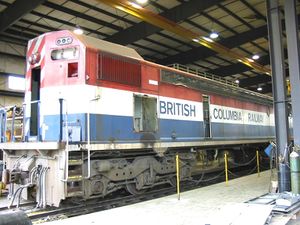
The railway also leased seven G6FC electric locomotives made by GMD for use on the electrified Tumbler Ridge Subdivision between 1983 and 2000, when the electrification was removed. In 2004, one was sold to the British Columbia Railway & Forest Industry Museum in Prince George, and the rest were scrapped.
For passenger service, the PGE purchased seven Budd Rail Diesel Cars (RDC) in 1956. Starting in the 1970s, the BCR started to purchase some used RDCs.[12] The RDCs were retired in 2002, when BC Rail ended its passenger services.
The BCR also used some historic locomotives for its Royal Hudson excursion service. The primary locomotive for the Royal Hudson excursion train was Canadian Pacific Railway No. 2860, a class H1 4-6-4 Royal Hudson. Made by MLW for the Canadian Pacific Railway in June 1940, it was the first locomotive built as a Royal Hudson. A sister locomotive, No. 2850, pulled King George VI's and Queen Elizabeth's royal train in 1939, and after the tour the King gave the CPR permission to use the term "Royal Hudson" for the class of locomotives. Between 1940 and 1956 it hauled transcontinental passenger trains between Revelstoke and Vancouver. Damaged in a derailment in 1956, it was refurbished and transferred to Winnipeg in 1957 for service on the prairies. It was withdrawn from service in May 1959, replaced by diesel locomotives. It was sold to the Vancouver Railway Museum Association in 1964 and was stored in Vancouver until 1973, when the British Columbia government acquired the locomotive from Joe. W. Hussey, who had purchased it three years earlier. It was restored and then leased to the British Columbia Railway, who used it in excursion service between 1973 and 2000. It was out of service during the 2001 tourist season, needing extensive repairs. The backup for No. 2060 was Canadian Pacific Railway No. 3716, a 2-8-0 built by MLW in 1912. During the 2001 season, when both steam locomotives were out of service, BC Rail leased No. 4069, a restored Canadian Pacific Railway FP7A diesel locomotive.
Notes
- ↑ About BC Rail: Facts & Figures. BC Rail. Retrieved on December 6, 2002.
- ↑ Andreae
- ↑ Sanford, p.60, Andreae, p. 194.
- ↑ Sanford p.72, Andreae, p. 195.
- ↑ Sanford, p.72.
- ↑ Horton, p.2.
- ↑ 7.0 7.1 7.2 $1-BILLION BC RAIL INVESTMENT PARTNERSHIP MOVES FORWARD. Province of British Columbia press releases. Retrieved on May 14, 2005.
- ↑ Schmidt.
- ↑ Schmidt
- ↑ "B.C. river's recovery from spill could take decades", CBC News, 2006-02-07. Retrieved on 2006-07-19.
- ↑ "Runaway locomotive may have triggered train derailment, RCMP says", CBC News, 2006-06-30. Retrieved on 2006-07-19.
- ↑ 12.0 12.1 12.2 Horton, p.16.
- ↑ Wade
References
- Andreae, Christopher (1997). Lines of country: an atlas of railway and waterway history in Canada. Boston Mills Press, Erin, Ontario. ISBN 1-55046-133-8.
- Garden, J.F. (August 1995). British Columbia Railway. This 450 page hard cover book covers the history of the PGE to the formation of BC Rail to British Columbia Railway and has hundreds of color prints.
- Garrett, Colin and Max Wade (1997). Locomotives: A complete history of the world's great locomotives and fabulous train journeys. London: Arness Publishing Limited. ISBN 1901289400.
- Horton, Timothy J. (1988). The British Columbia Railway (Volume One). B.R.M.N.A., Calgary, Alberta. ISBN 0-919487-28-9.
- Sanford, Barrie (1981). The Pictorial History of Railroading in British Columbia. Whitecap Books, Vancouver, British Columbia. ISBN 0-920620-27-2.
- Schmidt, Paul (May, 2003). "British Columbia seeks new BC Rail operator, retains right-of-way". Trains: p.11.
External links
- The BC Rail Story from CN's website, including photos
- West Coast Railway Association, focused on preserving "British Columbia's Railway heritage"
- November 2003 Announcement of the selection of CN, from the B.C. government website
- Billion-dollar B.C. Rail deal, a November 2003 article from a CBC website
- Points in the controversial sale, a November 14, 2003 article from TheTyee.com website
|
Current (operating) regional railways of Canada Former or fallen flag regional railways of Canada |
|
Current (operating) short line railways of Canada |
|
Former or fallen flag short line railways of Canada |
